第二讲 表面微机械加工技术应用
机床切削加工及应用—— 机械零件表面加工
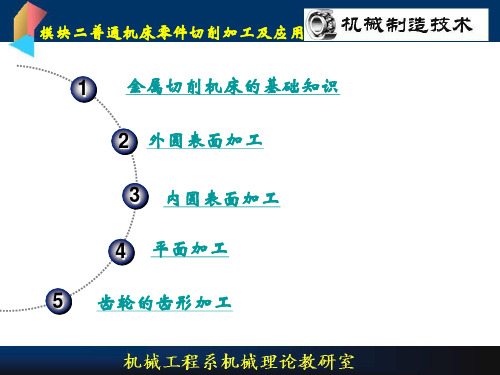
设计顺序号 设计单位代号
例如B1-015表示:北京第一机床厂设计制造的第15种专用机 床。
• 组合机床及其自动线:□-□△△△(□) 设计单位代号:由北京机床研究所统一规定。 分类代号 设计顺序号 重大改进顺序号 分类代号:U大型 H小型 K自动换刀(数 控)
8.1 金属切削机床的基础知识
8.1.3.零件表面的切削加工成形方法和机床的运动 1.零件表面的切削加工方法 机械零件的任何表面都可以看作是一条线(母线)沿另一 条线(导线)运动的轨迹。 常见表面:平面、外圆面、内圆面(孔)、锥面、曲面(成形面)
26 24 126 电动机(1440r/min)— —Ⅰ— 48 —Ⅱ— 256 30 42
如下图:车床传动路线表达式
42 60 42 —Ⅲ— 30 22 18 62 72
8.1 金属切削机床的基础知识
(3)机床的组别代号和系别代号
机床按其结构性能及使用范围,每类机床划分为10个组,每 个组又划分为10个系,分别用两位阿拉伯数字0~9表示,前 一位表示组别,后一位表示系别。
组别和系别代号用两位数字表示 两位数字:前——组别 后——系列
参见课本P.287 表8.1.3
成,用来实现车床的进给运动。主运动通过挂轮将运动传 给进给箱,进给箱通过光杠或丝杠将运动传给溜板箱和刀 架。溜板箱通过箱内各传动机构的不同组合,使刀架实现 纵向进给、横向进给、快速移动或车螺纹运动。
主轴箱
挂轮箱
刀架
尾座
丝杠 光杠
滑板
床身 进给箱
溜板箱 床腿
1—顶尖 2—套筒锁紧手柄 3—顶尖套筒 4—丝杆 5—螺母 6—尾座锁紧手柄 7—手轮 8—尾座体 9—底座
机械加工常见的表面处理种类和作用

机械加工常见表面处理的种类基本原理和用途表面处理工艺:静电喷涂、烤漆、镀锌、镀铬、镀镍、镀钛、镀金、镀银、铝阳极、浸渗、喷油、喷砂、DLC处理、铁氟龙处理、染黑、冷电镀静电喷涂:静电喷涂是利用高压静电电场使带负电的涂料微粒沿着电场相反的方向定向运动,并将涂料微粒吸附在工件表面的一种喷涂方法。
静电喷涂设备由喷枪、喷杯以及静电喷涂高压电源等组成。
静电喷涂的作用1、一次涂装可以得到较厚的涂层,例如涂覆100~300μm的涂层,用一般普通的溶剂涂料,约需涂覆4~6次,而用粉末涂料则一次就可以达到该厚度。
涂层的耐腐性能很好。
2、粉末涂料不含溶剂,无三废公害,改善了劳动卫生条件。
3、采用粉末静电喷涂等新工艺,效率高,适用于自动流水线涂装,粉末利用率高,可回收使用。
4、除热固性的环氧、聚酯、丙烯酸外,尚有大量的热塑性耐脂可作为粉末涂料,如聚乙烯、聚丙烯、聚苯乙烯、氟化聚醚、尼龙、聚碳酸脂以及各类含氟树脂等。
粉末涂料开始用于防护和电气缘方面,随着科技的发展,目前已广泛使用于汽车工业、电气绝缘、耐腐蚀化学泵、阀门、汽缸、管道、屋外钢制构件、钢制家具、铸件等表面的涂装。
我国自六十年代开始粉末涂装的实验研究,并在生产上得到应用。
发展到目前已广泛得到使用。
烤漆:在基材上打上底漆、面漆,每上一遍漆,都送入无尘衡温烤房,烘烤。
镀锌:是指在金属、合金或者其它材料的表面镀一层锌以起美观、防锈等作用的表面处理技术。
颜色有很多种,一般常见的有蓝白色、银白色等。
镀铬:在金属制品表面镀上一层致密的氧化铬薄膜,可以使得金属制品更加坚固耐用。
镀铬有两种的,一种是装饰铬,一种是硬铬。
镀硬铬一般采用比较多的是常在高温条件下使用的机械,如:模具等,镀装饰铬顾名思义,主要目的就是为了表面光亮、外形美观、防锈等等。
影响镀铬后表面粗糙度的因素工件表面镀铬后的表面粗糙度与以下条件有直接的关系:1、镀前基体的表面粗糙度(基体表面粗糙度值越小镀后表面粗糙度值也小);2、镀液温度的高低(温度高镀后表面粗糙度值就大);3、电流密度的大小(电流密度越大镀后表面粗糙度值就大);4、镀夜浓度(镀液浓度大镀后表面粗糙度值就大);5、电镀时间(电镀时间越长镀后表面粗糙度值就大)。
浅论微型机械加工技术及其应用
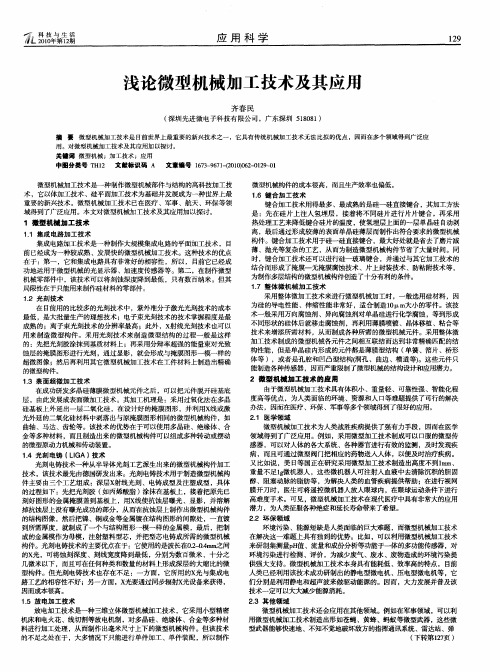
术一般采用万 向腐蚀剂 、异向腐蚀剂对单晶硅进行化学腐蚀 ,等到形成 不 同形状 的硅体后就移走腐蚀剂 , 再利用薄膜喷镀 、晶体移植、粘合等 技术来增 添所需材料,从而制成各种所需的微型机械元件。采用整体微 加工技术制成的微型机械各元件之间相互联结而达到非常精确匹配的结 构性能 , 但是单晶硅 内形成的元件都是薄膜型结构 ( 单簧、箔片、桥形 体等 ),或者是孔腔和 凹凸型结构( 洞孔、曲边、槽道等) 。这些元件只 能制造各种传感器 , 因而严重限制了微型机械的结构设计和应用潜力。 2 微型 机械 加工 技术 的应 用
1 微型 机械 加工技 术
11 集成 电路 J -技 术 . jr n
集成 电路加工技术是一种制作大规模集成 电路的平 面加工技术 ,目 前 已经成为一种较成熟 、发展快 的微型机枕 9工技术。这种技术的优点 口 在于 :第一 ,它和集成 电路具有非常好 的相容性 ,所 以,目前它已经成 功地运用于微型机械的光显示器 、加速度传感器等。第二 ,在制作微型 机械零部件中 ,该技术可以将刻蚀深度 降到最低 ,只有数百纳米 。但其 局限性在于只能用来制作硅材料的零部件。
构件。键合加工技术用于硅一硅直接键合 ,最大好处就是省去了磨片减 薄、抛光等复杂的工艺 ,从而为制造微 型机械构件节省 了大量时间。同 时, 键合加工技术还可以进行硅—玻璃键合 ,并通过与其它加工技术 的 结合而形成了掩 映一无掩膜腐蚀技术 、片上封装技术 、防粘附技术等 ,
为制作多层结构的微型机械构件创造了十分有利 的条件。 17 整 体 微 机 械 加 工 技 术 - 采用整体微加工技术来进行微型机械加工时,一般选用硅材料,因 为硅的导电性 能、伸缩性能非常好 , 适合制造 1 O 大小的零件 。该技 m
微细机械制造技术的研究与应用
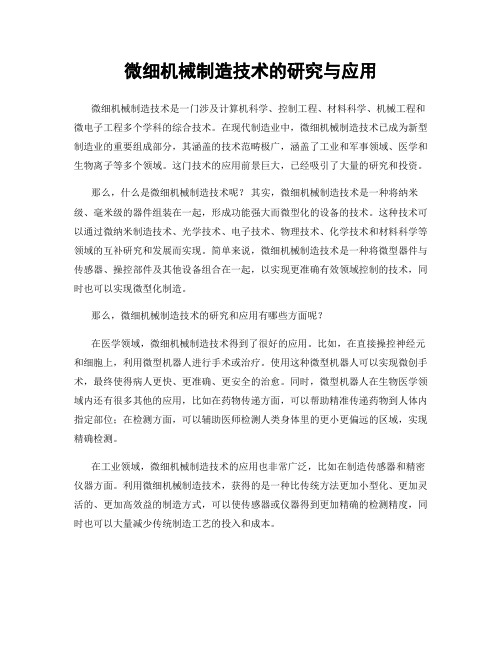
微细机械制造技术的研究与应用微细机械制造技术是一门涉及计算机科学、控制工程、材料科学、机械工程和微电子工程多个学科的综合技术。
在现代制造业中,微细机械制造技术已成为新型制造业的重要组成部分,其涵盖的技术范畴极广,涵盖了工业和军事领域、医学和生物离子等多个领域。
这门技术的应用前景巨大,已经吸引了大量的研究和投资。
那么,什么是微细机械制造技术呢?其实,微细机械制造技术是一种将纳米级、毫米级的器件组装在一起,形成功能强大而微型化的设备的技术。
这种技术可以通过微纳米制造技术、光学技术、电子技术、物理技术、化学技术和材料科学等领域的互补研究和发展而实现。
简单来说,微细机械制造技术是一种将微型器件与传感器、操控部件及其他设备组合在一起,以实现更准确有效领域控制的技术,同时也可以实现微型化制造。
那么,微细机械制造技术的研究和应用有哪些方面呢?在医学领域,微细机械制造技术得到了很好的应用。
比如,在直接操控神经元和细胞上,利用微型机器人进行手术或治疗。
使用这种微型机器人可以实现微创手术,最终使得病人更快、更准确、更安全的治愈。
同时,微型机器人在生物医学领域内还有很多其他的应用,比如在药物传递方面,可以帮助精准传递药物到人体内指定部位;在检测方面,可以辅助医师检测人类身体里的更小更偏远的区域,实现精确检测。
在工业领域,微细机械制造技术的应用也非常广泛,比如在制造传感器和精密仪器方面。
利用微细机械制造技术,获得的是一种比传统方法更加小型化、更加灵活的、更加高效益的制造方式,可以使传感器或仪器得到更加精确的检测精度,同时也可以大量减少传统制造工艺的投入和成本。
此外,在军品制造领域,微细机械制造技术也被广泛应用。
比如,在军事高技术装备制造中,可以利用微型机器人来实现自动化加工,减少手工操作,实现更高质量的制造。
同时,还可以利用微型机器人在危险地区进行资源精准管理等工作。
随着科技的不断更新和发展,微细机械制造技术在未来的发展与应用上,还将呈现更为广阔的发展前景。
机械加工中的原理与应用
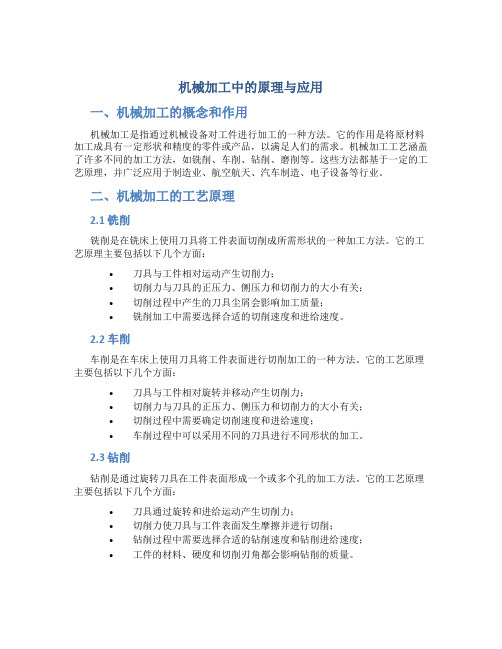
机械加工中的原理与应用一、机械加工的概念和作用机械加工是指通过机械设备对工件进行加工的一种方法。
它的作用是将原材料加工成具有一定形状和精度的零件或产品,以满足人们的需求。
机械加工工艺涵盖了许多不同的加工方法,如铣削、车削、钻削、磨削等。
这些方法都基于一定的工艺原理,并广泛应用于制造业、航空航天、汽车制造、电子设备等行业。
二、机械加工的工艺原理2.1 铣削铣削是在铣床上使用刀具将工件表面切削成所需形状的一种加工方法。
它的工艺原理主要包括以下几个方面:•刀具与工件相对运动产生切削力;•切削力与刀具的正压力、侧压力和切削力的大小有关;•切削过程中产生的刀具尘屑会影响加工质量;•铣削加工中需要选择合适的切削速度和进给速度。
2.2 车削车削是在车床上使用刀具将工件表面进行切削加工的一种方法。
它的工艺原理主要包括以下几个方面:•刀具与工件相对旋转并移动产生切削力;•切削力与刀具的正压力、侧压力和切削力的大小有关;•切削过程中需要确定切削速度和进给速度;•车削过程中可以采用不同的刀具进行不同形状的加工。
2.3 钻削钻削是通过旋转刀具在工件表面形成一个或多个孔的加工方法。
它的工艺原理主要包括以下几个方面:•刀具通过旋转和进给运动产生切削力;•切削力使刀具与工件表面发生摩擦并进行切削;•钻削过程中需要选择合适的钻削速度和钻削进给速度;•工件的材料、硬度和切削刃角都会影响钻削的质量。
2.4 磨削磨削是使用磨料粒子对工件表面进行切削加工的一种方法。
它的工艺原理主要包括以下几个方面:•磨料粒子在刀具与工件之间产生摩擦力,并对工件表面进行磨削;•磨削过程中需要选择合适的磨削速度和磨削压力;•磨削可以用于加工高硬度、高精度要求的工件;•磨削过程中会产生大量的热量,需要进行冷却处理。
三、机械加工的应用机械加工在许多行业中都有广泛的应用,下面列举了一些常见的应用场景:•制造业:机械加工是制造业的基本工艺之一,用于生产机械设备、汽车零件、电子产品等;•航空航天工业:飞机、导弹、卫星等的零部件制造都需要机械加工;•建筑工程:大型建筑结构的加工和制造也需要机械加工技术;•医疗器械:医用器械的制造和加工也依赖于机械加工。
微型机械加工技术的研究与应用
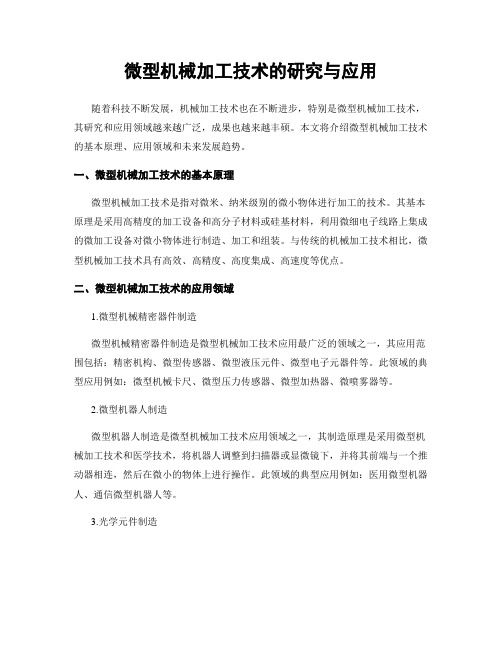
微型机械加工技术的研究与应用随着科技不断发展,机械加工技术也在不断进步,特别是微型机械加工技术,其研究和应用领域越来越广泛,成果也越来越丰硕。
本文将介绍微型机械加工技术的基本原理、应用领域和未来发展趋势。
一、微型机械加工技术的基本原理微型机械加工技术是指对微米、纳米级别的微小物体进行加工的技术。
其基本原理是采用高精度的加工设备和高分子材料或硅基材料,利用微细电子线路上集成的微加工设备对微小物体进行制造、加工和组装。
与传统的机械加工技术相比,微型机械加工技术具有高效、高精度、高度集成、高速度等优点。
二、微型机械加工技术的应用领域1.微型机械精密器件制造微型机械精密器件制造是微型机械加工技术应用最广泛的领域之一,其应用范围包括:精密机构、微型传感器、微型液压元件、微型电子元器件等。
此领域的典型应用例如:微型机械卡尺、微型压力传感器、微型加热器、微喷雾器等。
2.微型机器人制造微型机器人制造是微型机械加工技术应用领域之一,其制造原理是采用微型机械加工技术和医学技术,将机器人调整到扫描器或显微镜下,并将其前端与一个推动器相连,然后在微小的物体上进行操作。
此领域的典型应用例如:医用微型机器人、通信微型机器人等。
3.光学元件制造光学元件制造是微型机械加工技术应用领域之一,其主要方式是利用激光微加工技术对微型光学元件进行制作。
光学元件包括激光腔、波导器、微透镜、衍射光栅等,这些元件是通讯光学、高速光电信等领域中不可或缺的组成部分。
4.微型加工制造微型加工制造是微型机械加工技术应用领域之一,其主要目标是将微小物体加工成功能性部件。
微型加工制造是通讯、电子、自动化、精密仪器、汽车等领域的重要制造工艺,尤其是在高精度、微小产品制造领域中得到广泛应用。
此领域的典型应用例如:微型芯片加工、微型孔加工等。
三、微型机械加工技术的未来发展趋势1.高精度微加工技术高精度微加工技术是未来微型机械加工的重要发展方向,为了使高精度微加工得以实现,需要采用更精细的加工设备、更高度的自动化控制技术。
机械加工常见的表面处理种类和作用

机械加工常见的表面处理种类和作用机械加工常见表面处理的种类基本原理和用途表面处理工艺:静电喷涂、烤漆、镀锌、镀铬、镀镍、镀钛、镀金、镀银、铝阳极、浸渗、喷油、喷砂、DLC处理、铁氟龙处理、染黑、冷电镀静电喷涂:静电喷涂是利用高压静电电场使带负电的涂料微粒沿着电场相反的方向定向运动,并将涂料微粒吸附在工件表面的一种喷涂方法。
静电喷涂设备由喷枪、喷杯以及静电喷涂高压电源等组成。
静电喷涂的作用1、一次涂装可以得到较厚的涂层,例如涂覆100~300μm的涂层,用一般普通的溶剂涂料,约需涂覆4~6次,而用粉末涂料则一次就可以达到该厚度。
涂层的耐腐性能很好。
2、粉末涂料不含溶剂,无三废公害,改善了劳动卫生条件。
3、采用粉末静电喷涂等新工艺,效率高,适用于自动流水线涂装,粉末利用率高,可回收使用。
4、除热固性的环氧、聚酯、丙烯酸外,尚有大量的热塑性耐脂可作为粉末涂料,如聚乙烯、聚丙烯、聚苯乙烯、氟化聚醚、尼龙、聚碳酸脂以及各类含氟树脂等。
粉末涂料开始用于防护和电气缘方面,随着科技的发展,目前已广泛使用于汽车工业、电气绝缘、耐腐蚀化学泵、阀门、汽缸、管道、屋外钢制构件、钢制家具、铸件等表面的涂装。
我国自六十年代开始粉末涂装的实验研究,并在生产上得到应用。
发展到目前已广泛得到使用。
烤漆:在基材上打上底漆、面漆,每上一遍漆,都送入无尘衡温烤房,烘烤。
镀锌:是指在金属、合金或者其它材料的表面镀一层锌以起美观、防锈等作用的表面处理技术。
颜色有很多种,一般常见的有蓝白色、银白色等。
镀铬:在金属制品表面镀上一层致密的氧化铬薄膜,可以使得金属制品更加坚固耐用。
镀铬有两种的,一种是装饰铬,一种是硬铬。
镀硬铬一般采用比较多的是常在高温条件下使用的机械,如:模具等,镀装饰铬顾名思义,主要目的就是为了表面光亮、外形美观、防锈等等。
影响镀铬后表面粗糙度的因素工件表面镀铬后的表面粗糙度与以下条件有直接的关系:1、镀前基体的表面粗糙度(基体表面粗糙度值越小镀后表面粗糙度值也小);2、镀液温度的高低(温度高镀后表面粗糙度值就大);3、电流密度的大小(电流密度越大镀后表面粗糙度值就大);4、镀夜浓度(镀液浓度大镀后表面粗糙度值就大);5、电镀时间(电镀时间越长镀后表面粗糙度值就大)。
微模具制作的微机械加工技术应用探析
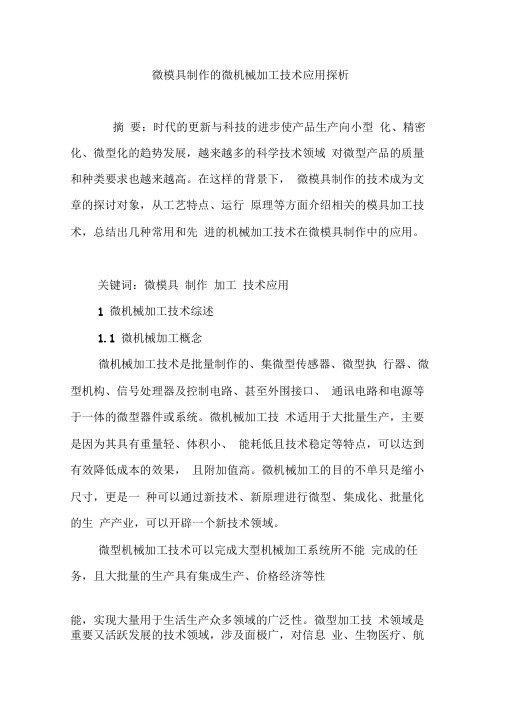
微模具制作的微机械加工技术应用探析摘要:时代的更新与科技的进步使产品生产向小型化、精密化、微型化的趋势发展,越来越多的科学技术领域对微型产品的质量和种类要求也越来越高。
在这样的背景下,微模具制作的技术成为文章的探讨对象,从工艺特点、运行原理等方面介绍相关的模具加工技术,总结出几种常用和先进的机械加工技术在微模具制作中的应用。
关键词:微模具制作加工技术应用1 微机械加工技术综述1.1 微机械加工概念微机械加工技术是批量制作的、集微型传感器、微型执行器、微型机构、信号处理器及控制电路、甚至外围接口、通讯电路和电源等于一体的微型器件或系统。
微机械加工技术适用于大批量生产,主要是因为其具有重量轻、体积小、能耗低且技术稳定等特点,可以达到有效降低成本的效果,且附加值高。
微机械加工的目的不单只是缩小尺寸,更是一种可以通过新技术、新原理进行微型、集成化、批量化的生产产业,可以开辟一个新技术领域。
微型机械加工技术可以完成大型机械加工系统所不能完成的任务,且大批量的生产具有集成生产、价格经济等性能,实现大量用于生活生产众多领域的广泛性。
微型加工技术领域是重要又活跃发展的技术领域,涉及面极广,对信息业、生物医疗、航天航空、国防科技、环境、经济等的建设密切相关,其未来发展拥有巨大前景。
1.2 微机械加工包含内容微机械加工技术属于高科技领域,它的发展与新技术的实现同时涉及到诸多其他领域及其技术的发展,如微电子加工技术。
适用于微模具制造领域的微机械加工主要技术有:硅体微加工技术、LIGA 模具加工制造技术、准LIGA 加工技术、激光烧蚀模具制作技术、光学光刻技术、微电火花模具加工技术和机械模具制造微加工技术等。
2 微机械加工技术及应用2.1 微细特种加工技术及应用2.1.1 加工技术指不依赖切削能量方式而通过其如光、热、化学、声和电等来去除材料的新型加工方法的总称。
这种加工技术同其他技术如LIGA、MEMS 等相比,具有加工方法简单、操作性强的特点,并且这种技术可以处理的材料也更加广泛,如合金、金属、陶瓷和半导体硅材料等,使得其在复杂型面、难切削材料和低刚度材料的模具型腔加工工作具有较大的优势。
表面工程技术在工程机械中的应用

表面工程技术在工程机械中的应用表面工程技术在工程机械中的应用表面工程技术在工程机械中的应用12级材控2班程明龙(1210121078)[摘要]介绍了表面工程技术的作用、内容,讨论了表面工程技术在工程机械中的4类主要作用,分析了涂装、磷化、电镀、抛丸、热处理等表面工程技术在工程机械行业中的应用现状,指出了这些技术在未来的发展趋势。
[关键词]表面工程;涂装;强化;热处理;表面处理近年来,表面工程技术取得了快速的发展,表面处理已经成为各项工程设计的一项主要内容。
在机械制造中,通过对材料或产品的表面进行一定处理,不仅可以提高性能和质量,如耐蚀性、耐磨性、抗氧化性等,确保产品安全可靠、延长寿命,还可以美化外观,提高产品附加值和市场竞争力。
在工程机械行业中,表面工程技术得到了广泛的应用,为提高工程机械产品的性能、质量和改善外观起到了重要的作用。
1 表面工程概述1.1表面工程的定义表面工程是将材料表面与基体作为一个系统进行设计,利用表面改性技术、薄膜技术和涂镀层技术,使材料表面获得材料本身没有而又希望具有的性能的系统工程[1]。
它包括涂镀层材料与工艺、施涂与检测设备、表面组成与结构分析技术、表面性能测试技术、检测方法、标准评价、质量保证与工艺过程控制等为制造新型表面和表面层而形成工程化、规模化的成套技术。
总之,在材料或产品表面所获得的与基体本身在性能上存在差异的表层的技术都属于表面工程。
1.2表面工程的作用表面工程以最经济和最有效的方法改变材料表面及近表面区的形态、化学成分和组织结构,或分,从而改变其性能。
主要包括化学热处理、阳极氧化、表面合金化和离子注入等。
(3)表面处理技术。
是通过加热或机械处理,在不改变材料表层化学成分的情况下,使其结构发生变化,从而改变性能。
常用的表面处理技术包括表面淬火、激光重熔和喷丸等。
2 表面工程技术在工程机械中的作用2.1 防锈保护工程机械的零部件绝大多数为金属材质,而设备基本上都在室外露天作业,裸露的金属很容易发生腐蚀。
精密机械零部件加工中的表面处理技术
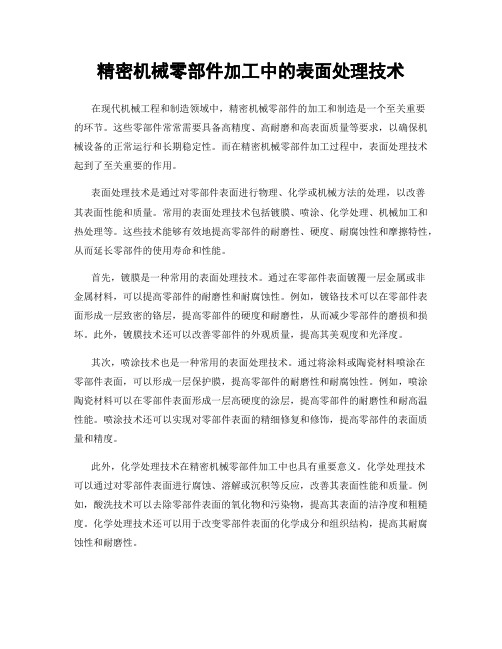
精密机械零部件加工中的表面处理技术在现代机械工程和制造领域中,精密机械零部件的加工和制造是一个至关重要的环节。
这些零部件常常需要具备高精度、高耐磨和高表面质量等要求,以确保机械设备的正常运行和长期稳定性。
而在精密机械零部件加工过程中,表面处理技术起到了至关重要的作用。
表面处理技术是通过对零部件表面进行物理、化学或机械方法的处理,以改善其表面性能和质量。
常用的表面处理技术包括镀膜、喷涂、化学处理、机械加工和热处理等。
这些技术能够有效地提高零部件的耐磨性、硬度、耐腐蚀性和摩擦特性,从而延长零部件的使用寿命和性能。
首先,镀膜是一种常用的表面处理技术。
通过在零部件表面镀覆一层金属或非金属材料,可以提高零部件的耐磨性和耐腐蚀性。
例如,镀铬技术可以在零部件表面形成一层致密的铬层,提高零部件的硬度和耐磨性,从而减少零部件的磨损和损坏。
此外,镀膜技术还可以改善零部件的外观质量,提高其美观度和光泽度。
其次,喷涂技术也是一种常用的表面处理技术。
通过将涂料或陶瓷材料喷涂在零部件表面,可以形成一层保护膜,提高零部件的耐磨性和耐腐蚀性。
例如,喷涂陶瓷材料可以在零部件表面形成一层高硬度的涂层,提高零部件的耐磨性和耐高温性能。
喷涂技术还可以实现对零部件表面的精细修复和修饰,提高零部件的表面质量和精度。
此外,化学处理技术在精密机械零部件加工中也具有重要意义。
化学处理技术可以通过对零部件表面进行腐蚀、溶解或沉积等反应,改善其表面性能和质量。
例如,酸洗技术可以去除零部件表面的氧化物和污染物,提高其表面的洁净度和粗糙度。
化学处理技术还可以用于改变零部件表面的化学成分和组织结构,提高其耐腐蚀性和耐磨性。
另外,机械加工技术在精密机械零部件加工中也不可或缺。
通过对零部件表面进行切削、研磨和抛光等机械加工操作,可以提高零部件的表面粗糙度和平整度,从而改善其摩擦特性和密封性能。
机械加工技术还可以实现对零部件表面形状和尺寸的精确控制,确保零部件的几何精度和尺寸精度。
中职课程《机械加工技术》精品课件之典型表面的机械加工

内圆磨头上装有内圆磨具5,用来磨削内圆。它由电动机经平 带带动主轴高速回转(10 000 r/min以上),实现内圆磨削的主运 动。不用时,将内圆磨头翻转到砂轮架上方,磨内圆时翻下。
任务1 内、外圆表面的机械加工
活动1 万能外圆磨床的切削运动 1.主运动
任务3 螺纹表面的机械加工
【任务描述】
1.了解螺纹的分类、种类、代号及各部分的名称。 2.熟悉螺纹车刀的刃磨与装刀要求。 3.掌握车削普通螺纹的进刀方法和切削用量选择。 4.了解车螺纹时乱扣原因,掌握克服乱扣的方法。 5.了解套螺纹与攻螺纹的方法。
任务3 螺纹表面的机械加工
【任务分析】
在各种机械产品中,带有螺纹的零件应用广泛。车削 螺纹是螺纹加工的常用方法,本任务主要介绍车削普通螺 纹的方法、原理等,并简要介绍螺纹加工的其他方法,即 套螺纹与攻螺纹。
(1)螺纹牙型。 (2)牙型角α。 (3)螺距P。 (4)导程Ph。 (5)大径D(d)。 (6)中径D2(d2)。 (7)小径D1(d1)。 (8)原始三角形高度h。 (9)螺旋升Байду номын сангаасλ。
图4-18普通螺纹基本牙型
任务3 螺纹表面的机械加工
活动2 螺纹车刀的刃磨与装刀要求 1.螺纹车刀的刃磨要求 (1)车刀的左右切削刃必须是直线,且无崩刃。 (2)根据粗、精车的要求,刃磨时要磨出合理的背前角和两侧后 角。粗车刀背前角大,后角小;精车刀则相反。 (3)刀头不应歪斜,车出螺纹的牙型半角α2必须相等。 (4)高速车削时,牙型角会扩大,此时,要将车刀刀尖角适当减 少约30′。 (5)内螺纹车刀刀尖平分线必须与刀柄垂直,其后角应适当大些。
万能外圆磨床磨削工件时砂轮的回转运动为主运动。
模具制造中表面工程技术的应用及实践
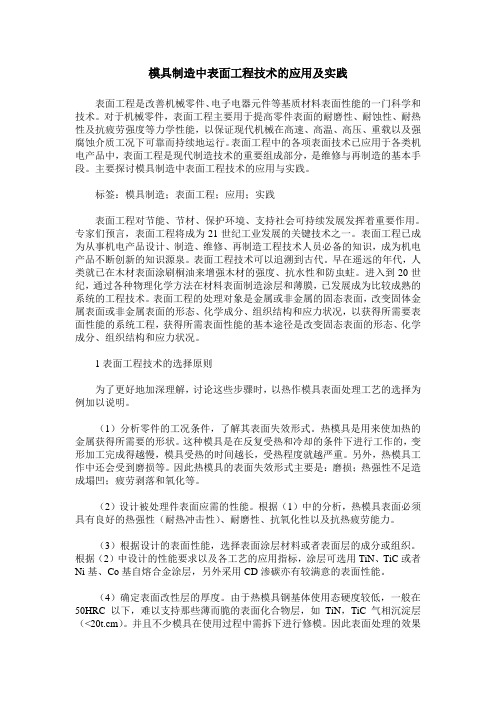
模具制造中表面工程技术的应用及实践表面工程是改善机械零件、电子电器元件等基质材料表面性能的一门科学和技术。
对于机械零件,表面工程主要用于提高零件表面的耐磨性、耐蚀性、耐热性及抗疲劳强度等力学性能,以保证现代机械在高速、高温、高压、重载以及强腐蚀介质工况下可靠而持续地运行。
表面工程中的各项表面技术已应用于各类机电产品中,表面工程是现代制造技术的重要组成部分,是维修与再制造的基本手段。
主要探讨模具制造中表面工程技术的应用与实践。
标签:模具制造;表面工程;应用;实践表面工程对节能、节材、保护环境、支持社会可持续发展发挥着重要作用。
专家们预言,表面工程将成为21世纪工业发展的关键技术之一。
表面工程已成为从事机电产品设计、制造、维修、再制造工程技术人员必备的知识,成为机电产品不断创新的知识源泉。
表面工程技术可以追溯到古代。
早在遥远的年代,人类就已在木材表面涂刷桐油来增强木材的强度、抗水性和防虫蛀。
进入到20世纪,通过各种物理化学方法在材料表面制造涂层和薄膜,已发展成为比较成熟的系统的工程技术。
表面工程的处理对象是金属或非金属的固态表面,改变固体金属表面或非金属表面的形态、化学成分、组织结构和应力状况,以获得所需要表面性能的系统工程,获得所需表面性能的基本途径是改变固态表面的形态、化学成分、组织结构和应力状况。
1表面工程技术的选择原则为了更好地加深理解,讨论这些步骤时,以热作模具表面处理工艺的选择为例加以说明。
(1)分析零件的工况条件,了解其表面失效形式。
热模具是用来使加热的金属获得所需要的形状。
这种模具是在反复受热和冷却的条件下进行工作的,变形加工完成得越慢,模具受热的时间越长,受热程度就越严重。
另外,热模具工作中还会受到磨损等。
因此热模具的表面失效形式主要是:磨损;热强性不足造成塌凹;疲劳剥落和氧化等。
(2)设计被处理件表面应需的性能。
根据(1)中的分析,热模具表面必须具有良好的热强性(耐热冲击性)、耐磨性、抗氧化性以及抗热疲劳能力。
MEMS工艺表面微机械加工技术

综上,可以看出,刻蚀选择性应当尽可能地大。
•构造层和牺牲层材料的制备方法
实际中广泛应用到的构造层和牺牲层材料的淀积方法是化学气相沉积〔CVD〕, 根据提供能量不同有如下分类:
LPCVD沉积腔(多 个温度区用于提高材 料生长的均匀性)
在MEMS中应用的LPCVD材料主要有三种:多晶硅、氮化硅和二氧化硅:
2.它制造的机械结构基本上都是二 维,因为机械 结构的厚度完全受限 于沉积薄膜的厚度。
2.由于体微机械加工 工艺无法做到零部件 的平面化布局,因此 它不能够和微电子线 路直接兼容。
二、根本工艺流程
•举例:方案一 —— 微型马达根本制造工艺流程
a) 在硅片上淀积一层牺牲层。 b) 淀积多晶硅作为构造层材料,制造转子。 c) 光刻胶作掩膜,反响离子刻蚀使图形转移到多晶硅构造层上。 d) 硅片外表沉积另一层氧化物牺牲层〔材料可能与前一层不同,常选择
表面微机械加工
体微机械加工
充分利用了现有的IC生产工艺,对 可以相对容易地 制造
优点 机械零部件尺度的控制与IC一样好, 出大质量的零部 件。 因此这种技术和IC完全兼容。
1.机械加工层越 多微 型元件的布局 1.很难制造精细灵敏 问题、平面化问题 和减小残余应力 的悬挂系统。 问题也更难解决。
缺点
LPCVD 二氧化硅〕 e) 加工出与衬底相连的锚区窗口〔为了制造定子,限制转子的侧向平移〕 f) 沉积第二层构造层,该构造层通过锚区窗口与衬底相连〔制造定子〕 g) 再次涂敷光刻胶用于光刻第二层构造形状。 h) 浸入氢氟酸刻蚀液以除去两层牺牲层。
•方案一带来的问题:
定子 转子 衬底
1. 转子在重力作用下很容易落在衬底上,产生大面积接触。 2. 转子在高速转动过程中会与定子产生接触,产生额外的摩
机械加工常见的表面处理种类和作用

机械加工常见表面处理的种类基本原理和用途表面处理工艺:静电喷涂、烤漆、镀锌、镀铬、镀镍、镀钛、镀金、镀银、铝阳极、浸渗、喷油、喷砂、DLC处理、铁氟龙处理、染黑、冷电镀静电喷涂:静电喷涂是利用高压静电电场使带负电的涂料微粒沿着电场相反的方向定向运动,并将涂料微粒吸附在工件表面的一种喷涂方法。
静电喷涂设备由喷枪、喷杯以及静电喷涂高压电源等组成。
静电喷涂的作用1、一次涂装可以得到较厚的涂层,例如涂覆100~300μm的涂层,用一般普通的溶剂涂料,约需涂覆4~6次,而用粉末涂料则一次就可以达到该厚度。
涂层的耐腐性能很好。
2、粉末涂料不含溶剂,无三废公害,改善了劳动卫生条件。
3、采用粉末静电喷涂等新工艺,效率高,适用于自动流水线涂装,粉末利用率高,可回收使用。
4、除热固性的环氧、聚酯、丙烯酸外,尚有大量的热塑性耐脂可作为粉末涂料,如聚乙烯、聚丙烯、聚苯乙烯、氟化聚醚、尼龙、聚碳酸脂以及各类含氟树脂等。
粉末涂料开始用于防护和电气缘方面,随着科技的发展,目前已广泛使用于汽车工业、电气绝缘、耐腐蚀化学泵、阀门、汽缸、管道、屋外钢制构件、钢制家具、铸件等表面的涂装。
我国自六十年代开始粉末涂装的实验研究,并在生产上得到应用。
发展到目前已广泛得到使用。
烤漆:在基材上打上底漆、面漆,每上一遍漆,都送入无尘衡温烤房,烘烤。
镀锌:是指在金属、合金或者其它材料的表面镀一层锌以起美观、防锈等作用的表面处理技术。
颜色有很多种,一般常见的有蓝白色、银白色等。
镀铬:在金属制品表面镀上一层致密的氧化铬薄膜,可以使得金属制品更加坚固耐用。
镀铬有两种的,一种是装饰铬,一种是硬铬。
镀硬铬一般采用比较多的是常在高温条件下使用的机械,如:模具等,镀装饰铬顾名思义,主要目的就是为了表面光亮、外形美观、防锈等等。
影响镀铬后表面粗糙度的因素工件表面镀铬后的表面粗糙度与以下条件有直接的关系:1、镀前基体的表面粗糙度(基体表面粗糙度值越小镀后表面粗糙度值也小);2、镀液温度的高低(温度高镀后表面粗糙度值就大);3、电流密度的大小(电流密度越大镀后表面粗糙度值就大);4、镀夜浓度(镀液浓度大镀后表面粗糙度值就大);5、电镀时间(电镀时间越长镀后表面粗糙度值就大)。
微细加工技术及其应用
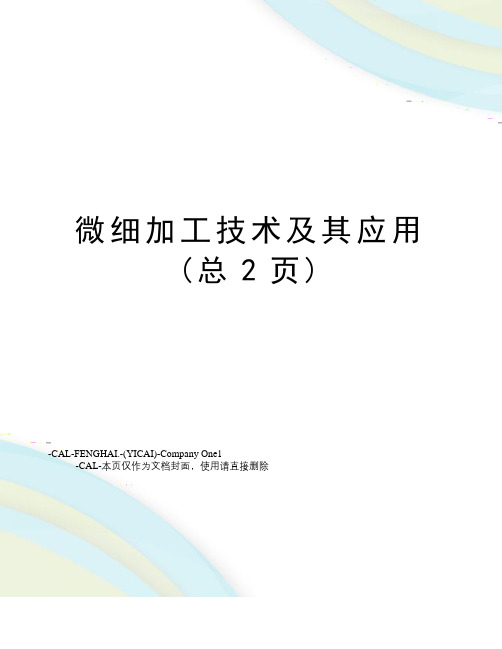
微细加工技术及其应用(总2页)-CAL-FENGHAI.-(YICAI)-Company One1-CAL-本页仅作为文档封面,使用请直接删除微细加工技术及其应用微细加工技术是由瑞士BinC公司发明的一种新型加工工艺,在2004年法国巴黎举办的国际表面处理展览会(SITS)和2004年在法国里昂举办的ALLIANCE展览会上荣获2项发明奖。
微细加工工艺和设备拥有国际专利保护。
微细加工技术结合了超精增亮和超精抛光两项革新技术,能够有选择性地保留表面的微观结构,以提高表面的摩擦和滑动性能(表面技术),以机械化和自动化取代传统的手工抛光,提高表面的美学功能。
这种微细加工技术应用于切削刀具、冲压和锻造工具,航空、汽车、医疗器械、塑料注射模具等机械零件的表面处理,能够极大地改善零件表面的性能。
微细加工原理微细加工技术采用全自动方式对金属零件表面进行超精加工,通过一种机械化学作用来清除金属零件表面上1~40μm的材料,实现被加工表面粗糙度达到或者好于ISO标准的N1级的表面质量。
微细加工技术主要应用于超精抛光和超精增亮这两个领域。
超精抛光使传统的手工抛光工艺自动化;而超精增亮则生成新的表面拓扑结构。
微细加工技术的一个突出优点是能够赋予零件表面新的微观结构。
这些微观结构能提高零件表面对特定应用功能的适应性。
如减小摩擦和机械差异、提高抗磨损性能、改善涂镀前后表面的沉积性能等。
总的说来,超精增亮可去除次级微观粗糙表面,次级粗糙表面的厚度在0~20μm之间,位于零件表面初级微观粗糙面的峰尖之间。
而超精抛光则部分或整体去除初级微观粗糙表面,其值在10~40μm之间,当然这取决于零件材料表面的初始状态。
微细加工技术迄今能够加工的材料有退火及淬火钢、铜及铜合金、铸铁、Inconel镍合金(镍基合金)、钛金属、表面硬涂层处理前后的预处理(PVD、CVD、电镀)。
技术专利微细加工技术是一种有选择性地精修被加工对象表面微观粗糙度和拓扑结构的创新性微观加工工艺。
- 1、下载文档前请自行甄别文档内容的完整性,平台不提供额外的编辑、内容补充、找答案等附加服务。
- 2、"仅部分预览"的文档,不可在线预览部分如存在完整性等问题,可反馈申请退款(可完整预览的文档不适用该条件!)。
- 3、如文档侵犯您的权益,请联系客服反馈,我们会尽快为您处理(人工客服工作时间:9:00-18:30)。
牺牲层技术刻蚀与选择性etch:To cut into the surface of (glass, for example) by the action of acid.Etching:The art of preparing etched plates, especially metal plates, from which designs and pictures are printed. Corrode:To destroy a metal or alloy gradually, especially by oxidation or chemical action其实刻蚀还包含分解、转化、溶解等一系列含义。
半导体技术的刻蚀并不仅仅局限于金属材料,半导体、化合物、包括有机物薄膜才是刻蚀研究的重点。
Etching还有一个特征:选择性或者局部队有控制刻蚀。
干法刻蚀也是半导体技术赋予Etching的新内涵。
选择性源于化学反应的热力学选择性和刻蚀过程度动力学因素控制。
下面这张表格概括了一些简单物质与常用反应物之间相互作用的规律,其中既有热力学因素控制的结果,也有动力学因素促成。
它们都是湿法反应机制度结果MUMPS工艺概况The MUMPS process is a three-layer polysilicon surface micromachining process derived from work performed at the Berkeley Sensors and Actuators Center (BSAC) at the University of California.Several modifications and enhancements have been made to increase the flexibility and versatility of the process for the multi-user environment. The process flow described below is designed to introduce inexperienced users to polysilicon micromachining. The text is supplemented by detailed drawings that show the process flow in the context of building a typical micromotor.工艺流程详解衬底:100 mm n-type (100) silicon wafers of 1-2 ohm-cm resistivity.低阻硅片1. The surface of the wafers are first heavily doped with phosphorus in a standard diffusion furnace using POCl3 as the dopant source.This helps to reduce or prevent charge feed through to the substrate from electrostatic devices on the surface.2. 600 nm low-stress LPCVD(low pressure chemical vapor deposition) silicon nitride layer is deposited on the wafers as an electrical isolation layer.3. deposition of a 500 nm LPCVD polysilicon film-Poly 0.4. the coating of the wafers with photoresist5. Exposure of the photoresist with the appropriate mask6. Developing the exposed photoresist to create the desired etch mask for subsequent pattern7. Transfer into the underlying layer -The Poly 0 layer is then etched in an RIE system只刻蚀多晶硅而不刻蚀硅,需要细致选择刻蚀剂和刻蚀工艺8. After etch, the photoresist is chemically stripped in a solvent bath.9. A 2.0 µm phosphosilicate glass (PSG) sacrificial layer is then deposited by LPCVD10. coating of the wafers with photoresist11 Exposure of the photoresist with the DIMPLES mask12. Developing the exposed photoresist to create the desired etch mask for subsequent pattern13. the 1st oxide layer is then etched in an RIE system to form dimples14. After etch, the photoresist is chemically stripped in a solvent bath.The depth of the dimples is 750 nm上述五步重复了前一次的过程,是表面微机械加工最典型的工艺循环15.-19 The wafers are then patterned with the third mask layer, ANCHOR1, and reactive ion etched. This step provides anchor holes that will be filled by the Poly 1 layer.第一层牺牲层经历了两次加工,为什么不一次完成?还有其它的技术途径选择吗?20. the first structural layer of polysilicon (Poly 1) is deposited ata thickness of 2.0 µm.21. A thin (200 nm) layer of PSG is deposited over the polysilicondimples 处的高度会有起伏,这里未有表达。
22. the wafer is annealed at 1050°C for 1 hour,The anneal dopes the polysilicon with phosphorus from the PSG layers both above and below it.The anneal also serves to significantly reduce the net stress in the Poly 1 layer.(为什么从两侧同时扩散掺杂?)23-27 The polysilicon (and its PSG masking layer) is lithographically patterned using a mask designed to form the first structural layer POLY1.(涂胶-光刻-显影-RIE刻蚀-去胶)刻蚀PSG和氮化硅的工艺参数不同,且有选择性,尤其应当注意通常PSG充当氮化硅刻蚀的硬掩膜,可以实现良好图形转移效果。
28.以RIE刻蚀清除表面的残余PSG(可以不去吗?)29.The second PSG layer (Second Oxide) is deposited(0.75µm)30-34 The POLY1_POLY2_VIA level provides for etch holes in the Second Oxide down to the Poly 1 layer. This provide a mechanical and electrical connection between the Poly 1 and Poly 2 layers.(部分清除第二层氧化硅以使即将沉积的第二层硅与第一层硅结合,同样经历涂胶-光刻-显影-RIE刻蚀-去胶循环)35-39.同样循环操作开出贯通上下的通孔,为制作固定连接的轴套留出空间(为什么要一次性刻穿第一第二层牺牲层?刻蚀终止于第一层硅可以吗?)40. The second structural layer, Poly 2, is then deposited (1.5 µm thick)41. the deposition of 200 nm PSG. On the top of POLY2(As with Poly 1, the thin PSG layer acts as both an etch mask and dopant source for Poly 2)42 The wafer is annealed for one hour at 1050° C to dope the polysilicon and reduce the residual film stress.43-47.The Poly 2 layer is lithographically patterned with the seventh mask (POLY2) and the PSG and polysilicon layers are etched by RIE using the same processing conditions as for Poly1 48.the masking oxide is removed49-54.The final deposited layer in the MUMPs process is a 0.5 µm metal layer that provides for probing, bonding, electrical routing and highly reflective mirror surfacesthe metal is deposited and patterned using lift-off(涂胶-光刻-显影-沉积金属-剥离光刻胶)55.分片、包装、发送给用户56刻蚀牺牲层(The release is performed by immersing the chip in a bath of 49% HF (room temperature) for 1.5-2 minutes.)57.This is followed by several minutes in DI water and then alcohol to reduce stiction followed by at least 10 minutes in an oven at 110° CSUMMiTSandia Ultra-planar, Multi-level MEMS Technology isA four-layer polycrystalline silicon surfacemicromachining process立意:The challenges associated with additional layers of polysilicon in a surface micromachining fabrication process are significant, and are primarily related to residual film stress and device topography. Fortunately, Sandia's SUMMiT TM Fabrication Process overcomes these challenges. 优势:∙Chemical-mechanical planarization eliminates inter-level interference∙Sandia's ultra-low-stress mechanical polysilicon maintains device integrity.∙Utilizes 1-micron design rulesWhy the another additional layer is important?with a ground plane and one mechanical layer (a so-called two-layer process), an actuating comb drive can be fabricated. With two mechanical layers, mechanisms such as a gear constrained to rotate on a hub, and various types ofmirrors are possible. When a third mechanical layer is added, the possiblities include not just linkages to connect actuators to mechanisms, but also an enormous range of new design possibilities that is staggering in scope.残余应力控制的重要性和结果Residual stress can result in the mechanical layers being bowed out of plane, resulting indifficult-to-calibrate devices, non-reproducible devices, or still worse, non-functioning devices. MEMS foundries, even those dealing with only one or twomechanical layers, often find it a challenge to reproducibly reduce polysilicon stress to an acceptable level. Sandia has developed a proprietary process through which it maintains stress levels at typically less than 5MPa. Meshed gears, each 2000 microns in diameter, have been successfully fabricated and operated.直径2毫米的薄膜齿轮共平面技术:Device topography can make it difficult to pattern and etch subsequent layers of polysilicon. In addition, topography can result in structural artifacts that severely constrain the range of designs that can be successfully implemented. To mitigate the problems caused by topography, Sandia has implemented a proprietary planarization method based on Chemical-Mechanical Polishing (CMP).。
